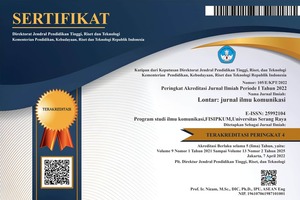The Issue of Teenage Girl Marriage in Indonesian Films: Analysis of the "Yuni" Film Reception
DOI:
https://doi.org/10.30656/lontar.v10i2.5081Keywords:
Audience Research, Film Reception, Gender Studies, Teen Marriage, Gender SeterotypeAbstract
The film titled “Yuni†talks about a young girl named Yuni who experiences pressure from her society to get married. Despite gaining international recognition through awards at prestigious events, this film has attracted various discourses on social media. This research aims to examine the audience’s meaning of the film “Yuniâ€, especially for women who have married in their teens. This is phenomenological research that focuses on the experience of the audience as individuals. The research method uses Stuart Hall’s reception analysis with the concept of encoding and decoding and uses the stereotype concept of Richard Dyer as an analytical tool. This research uses in-depth interviews, observations, and literature studies. The results show that the audience’s meaning is in a position of dominance and negotiation. A dominant position occurs through scenes that show that married teenage girls are victims of a still-strong cycle of patriarchal systems and we will limit the options to develop themselves for experience after marriage. The negotiating position occurs in scenes that show stereotypes related to women must be smart in matters of kitchens, wells, and beds.
References
Aristantya, E. K., & Helmi, A. F. (2019). Citra Tubuh pada Remaja Pengguna Instagram. Gadjah Mada Journal of Psychology (GamaJoP), 5(2), 114. https://doi.org/10.22146/gamajop.50624
Djamilah, & Kartikawati, R. (2015). Dampak Perkawinan Anak di Indonesia. Jurnal Studi Pemuda, 3(1), 1–16.
Dyer, R. (2012). Stereotyping. In M. G. Durham & D. M. Kellner (Eds.), Media and Cultural Studies: Keyworks, Revised Edition (2nd ed., pp. 275–282). Wiley-Blackwell.
Dyer, R. (2013). The matter of images: Essays on representations. Routledge. https://doi.org/10.4324/9780203378717
Fitriyani, D., Irawan, G., Susanah, S., Husin, F., Mose, J. C., & Sukandar, H. (2017). Kajian Kualitatif Faktor-Faktor yang Memengaruhi Pernikahan Remaja Perempuan. Jurnal Pendidikan Dan Pelayanan Kebidanan Indonesia, 2(3), 38. https://doi.org/10.24198/ijemc.v2i3.75
Giswandhani, M. (2022). Yuni: Stereotype Representation of Women. Journal of Business, Social and Technology (Bustechno), 3, 1–8.
Griffin, E., Ledbetter, A., & Sparks, G. G. (2018). A First Look at Communication Theory. In McGraw-Hill (10th ed.).
Hall, S. (2012). Encoding/Decoding. In M. G. Durham & D. M. Kellner (Eds.), Media and Cultural Studies: Keyworks, Revised Edition (2nd ed., pp. 137–144). Wiley-Blackwell.
Hidayah, S. N. A., Haslinda, H., & Karumpa, A. (2022). Feminisme dalam Film Yuni Karya Kamila Andini. Jurnal Konsepsi, 11(1), 143–157. https://
www.p3i.my.id/index.php/konsepsi/article/view/185
Komariyah, K., Ghufroni, G., & Nisa, H. U. (2022). Fenomena Diskriminasi Sosial dalam Film Yuni Karya Kamila Andini: Kajian Sosiologi Sastra. Jurnal Ilmiah Wahana Pendidikan, 8(20), 34–43.
Muntamah, A. L., Latifiani, D., & Arifin, R. (2019). Pernikahan Dini Di Indonesia: Faktor Dan Peran Pemerintah (Perspektif Penegakan Dan Perlindungan Hukum Bagi Anak). Widya Yuridika, 2(1), 1. https://doi.org/10.31328/wy.v2i1.823
Nainggolan, S. Y. (2021, December 9). Deretan Prestasi Film Yuni, Tayang Hari Ini di Bioskop. Medcom.Id. https://www.medcom.id/hiburan/film/0kpowwRb-deretan-prestasi-film-yuni-tayang-hari-ini-di-bioskop
Nurmala, M., Jayanti, R., & Hermawan, W. (2022). Konflik batin tokoh utama dan kearifan lokal pada film yuni sutradara kamila andini. PROSIDING SEMINAR NASIONALPENDIDIKAN FAKULTAS KEGURUAN DAN ILMU PENDIDIKAN UNIM, 1, 145–155.
Partini, Wahyuni, H. I., & Sadasri, L. M. (2020). Saving Indonesia’s Golden Generation: Preventing Teenage Marriage in Rembang, Central Java (A Case Study). IKAT: The Indonesian Journal of Southeast Asian Studies, 4(1), 63. https://doi.org/10.22146/ikat.v4i1.51554
Qoirunisya’, N., Wibowo, J. H., & Jupriono, J. (2022). REPRESENTASI PATRIARKI DALAM FILM YUNI. Seminar Nasional 2022 “Transformasi Digital Dalam Upaya Peningkatan Perekonomian Pasca Pandemi,†1(1), 1–4.
Santrock, J. W. (2011). Lifespan development (13th ed.). McGraw-Hill.
Sawyer, S. M., Azzopardi, P. S., Wickremarathne, D., & Patton, G. C. (2018). The age of adolescence. The Lancet Child & Adolescent Health, 2(3), 223–228. https://doi.org/https://doi.org/10.1016/ S2352-4642(18)30022-1
Shaw, A. (2017). Encoding and decoding affordances: Stuart Hall and interactive media technologies. Media, Culture and Society, 39(4), 592–602. https://doi.org/10.1177/0163443717692741
Suhariyati, Haryanto, J., & Probowati, R. (2019). Faktor-faktor yang berhubungan dengan pengambilan keputusan pernikahan remaja di kabupaten Bondowoso. Jurnal Penelitian Kesehatan Suara Forikes, 10(4), 1.
Downloads
Published
Issue
Section
License
By submitting an article to the journal, the author(s) agree to transfer the published article's copyright to the journal, which will act as the publisher. This means the journal will have the right to publish the article in various forms, including reprints. The journal will maintain the publishing rights to the published articles.
In line with the license, authors and third parties (readers, researchers, and others) are allowed to share and adapt the material. In addition, the material must be given appropriate credit, provided with a link to the license, and indicated if changes were made. If authors remix, transform, or build upon the material, authors must distribute their contributions under the same license as the original.





